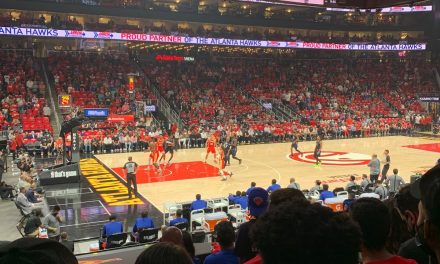In the past three days, the Emory women’s basketball team faced Maryville College (Tenn.) at home and Sewanee University (Tenn.) on the road. The team won both games and remains undefeated early in the season, with a 5-0 record overall. The team is currently ranked 12th in the nation.
In their matchup on Sunday at home against Maryville, the team faced its first scare of losing their undefeated season. The Eagles still pulled out a 68 to 67 win, but it wasn’t easy. With 33 seconds to go, Emory senior point guard Savannah Morgan made a clutch free throw to give Emory the 68-67 lead. The Eagles had two other opportunities at the line to widen the lead, but missed both times. The game came down to the last shot, with Maryville’s Mindy Brackins missing the potential game winning three-point shot.
Morgan and senior guard Selena Castillo paced the team in scoring, with 25 and 26 points respectively. Both shot over 50 percent from the field, and Morgan made four out of six attempts from the three-point line.
While they were outrebounded 45-35, their plus-11 turnover margin (27 turnovers for Maryville versus Emory’s 16) was the difference in the game. With their full court press on defense, Emory forces many turnovers, which gives the team extra possessions on offense. Despite only shooting 38 percent from the field, Emory’s extra possessions helped them pass the tough early season test. Against Sewanee, the result was not in question for most of the game. Once again, Emory’s full court press defense forced many mistakes by Sewanee, forcing an astounding 35 turnovers, while only committing 16 themselves. Much like the Maryville game, this gave Emory significantly more opportunities to score than their opponent. Also, forcing turnovers allows the team to push down the court on a fast break and get easy shots near the basket.
Additionally, the fast break is one of the better times to get open three-point shots. When a team is hustling back on defense, their first instinct is to protect the paint. However, often teams overcommit in the paint, leaving open easy opportunities for other players to spot up for an open three-point shot. Senior Hannah Lilly, Morgan and Castillo paced the team in scoring, all scoring double-digit points.
The team shot seven for 17 from the three-point line, an excellent shooting percentage from that distance. Also, the game was defensive throughout and those shots widened the gap between the two teams significantly.
While this year’s team does not have the size that it did last year, they have made up for it well with their versatility, depth and defensive intensity. The team sometimes plays 12, even 13 or 14 players each game, which helps keep the team fresh in the later stages of the game. Since the team is so deep, they can successfully implement a full court press, which takes a lot of energy out of the players. Their intensity wears down their opponent as the game progresses. The team can space the floor with a lot of shooters, and are athletic and willing to run in transition to get easy baskets. While they had a scare against Maryville, the team has to be satisfied with their start. Coming off their best season in school history last year, the expectations are high this season. However, this team looks well equipped to eclipse their Sweet 16 exit last year and possibly advance much further beyond.
At this point, they are ranked 12th in the nation and have a lot of work left to do. However, with their success last year and plenty of returning players, a run at the NCAA Division III title isn’t out of the question.
– By Shawn Farshchi
Photo courtesy of Emory Athletics
The Emory Wheel was founded in 1919 and is currently the only independent, student-run newspaper of Emory University. The Wheel publishes weekly on Wednesdays during the academic year, except during University holidays and scheduled publication intermissions.
The Wheel is financially and editorially independent from the University. All of its content is generated by the Wheel’s more than 100 student staff members and contributing writers, and its printing costs are covered by profits from self-generated advertising sales.






